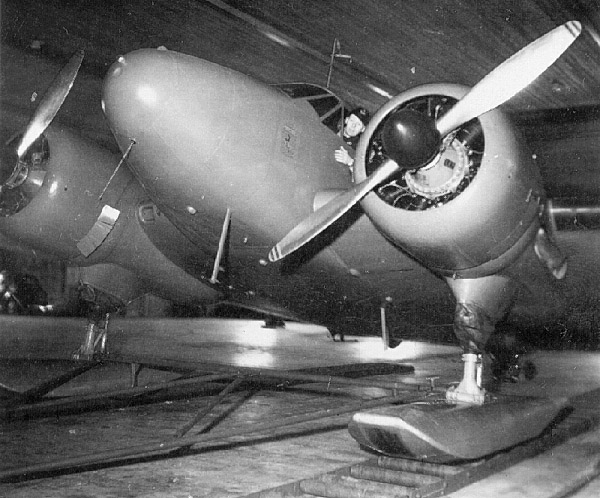|
|
||
Tp
4 – Beechcraft 18R Flying Ambulance (1940-1953)
|
||
|
|
Page 1 (1) | |
|
|
||
 |
||
|
As
a Tp 2A (Junkers W 34), based at Wing F 4 at Frösön, tragically
crashed in 1938, killing all five persons aboard, a new ambulance
aircraft was ordered in 1939. This time, a Beech 18R was acquired from
USA. The new flying ambulance had a lot of modern equipment – radio,
RDF (radio direction finder) and complete avionics for instrument
flying. It could be fitted with wheel landing gears, skis or floats.
And, not least important, the aircraft had two engines. The
story of 18R began in 1935, when the Beech Company began to develop a
light transport aircraft of all-metal type with a semi-monoque airframe,
cantilever wings, electrically retracted tailwheel landing gear and with
the vertical tail surfaces at the outer ends of the stabilizer. More
than 5.000 aircraft were built for the Allied forces during WWII and
used for various transport duties. The most common designations were
C-45 (USAAF), JRB (US Navy) and Expeditor (the British name). The
Swedish ambulance Beech was shipped in crates to Gothenburg in January
1940, where it was assembled. The trials were flown by the legendary
ambulance aviator Knut Gunnerfeldt. The Beechcraft, designated Tp 4, arrived at F 4 on the 6th of April.
The Tp 4 got the “Ambulance number” “7”, and also got the
RswAF/n “007”. In
December of 1941, the Tp 4 was re-based to the newly established Wing F
21 at Kallax near Luleå. In return, F 4 got the old Tp 2A No. 6. The Tp
4 served for nearly ten years in the most northern part of our country.
Many lives were saved due to the flying ambulance service. In
1951, the International Geophysical Year, the Tp 4, now under civil
registration, took part in an international South Pole expedition. In
the next year, the aircraft returned to the Air Force and to Wing F 4,
but now used for liaison and transport duties. In 1953, the aircraft
crashed just after a take-off from the ice. The legendary and very
experienced Knut Gunnerfelt was killed, but the other three aboard
survived. The Tp 4 was powered by two Wright Whirlwind R 975 E3 engines. Each engine delivered 450 hp. The two photos is submitted by Mikael Östberg, Umeå. His father, Karl-Gustav Östberg, made his military service as an aircraft mechanic at the flying ambulace at Wing F 21. At Mikaels web site "Flieger" you can find many more photos of the Tp 4 and also a lot of other unique photos of older and newer Swedish military aircraft as well as beautiful colour profiles. The text of the photo at top reads "On floats outside F4". This photo belongs to Björn Österberg.
The
photo at bottom is from the archive of Lennart Sandberg.
"Inside
hangar. Note: skis and rolling mat, orange paint, coat of arms on nose
and pilot "Doggen" Olsson." Length: 10,40 m. Span: 13,00. MTOW 2.710 kg. Max. speed: 285 km/h. |
||
 |
||
|
|
||
|
© Lars Henriksson |
Updated 2010-07-15 | |
|
|
||